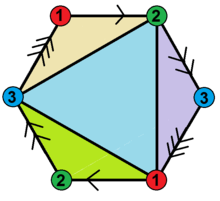Hemi-octahedron
| Hemi-octahedron | |
|---|---|
 | |
| Type |
abstract regular polyhedron globally projective polyhedron |
| Faces | 4 triangles |
| Edges | 6 |
| Vertices | 3 |
| Vertex configuration | 3.3.3.3 |
| Schläfli symbol | {3,4}/2 or {3,4}3 |
| Symmetry group | S4, order 24 |
| Dual polyhedron | hemicube |
| Properties |
non-orientable Euler characteristic 1 |
A hemi-octahedron is an abstract regular polyhedron, containing half the faces of a regular octahedron.
It has 4 triangular faces, 6 edges, and 3 vertices. Its dual polyhedron is the hemicube.
It can be realized as a projective polyhedron (a tessellation of the real projective plane by 4 triangles), which can be visualized by constructing the projective plane as a hemisphere where opposite points along the boundary are connected and dividing the hemisphere into four equal parts. It can be seen as a square pyramid without its base.
It can be represented symmetrically as a hexagonal or square Schlegel diagram:
It has an unexpected property that there are two distinct edges between every pair of vertices – any two vertices define a digon.
See also
References
- McMullen, Peter; Schulte, Egon (December 2002), "6C. Projective Regular Polytopes", Abstract Regular Polytopes (1st ed.), Cambridge University Press, pp. 162–165, ISBN 0-521-81496-0
External links
This article is issued from Wikipedia - version of the 10/22/2016. The text is available under the Creative Commons Attribution/Share Alike but additional terms may apply for the media files.
